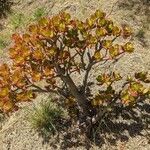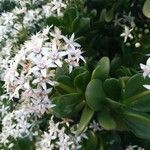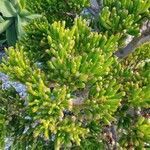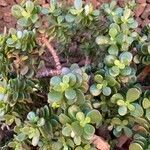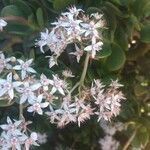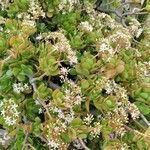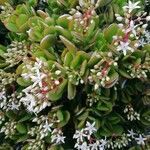Perennial shrub, succulent, 1.0-2.5 m high, much branched, old leaves deciduous. Leaves elliptic to oblanceolate, 20-30 x 10-18 mm, pointed or mucronate, cuneate towards base, convex on both surfaces, entire with or without red horny margins, green, shiny, older leaves with silvery scales; petioles absent or short. Inflorescence a rounded thyrse, several dichasia; peduncles 10-30 mm long. Calyx fleshy, glabrous, green, distinct ridge towards apex. Corolla star-shaped, fused at base, white tinged pink; lobes 7-10 mm long, sharply pointed, slightly hooded and slightly ridged, spreading at right angles. Flowering time May-Sept.
Leaves 2-5 x 1-3 cm., obovate or broadly elliptical to obovate-spathulate, shortly acuminate and acute or subrounded at the top, entire and reddish at the sharply edged margin, attenuate towards a subpetiolar base, subconnate when young, free with age, fleshy, flattened, slightly concave above and slightly convex beneath, with nectary dots in one row on both sides near the margin (but dots also scattered on both surfaces), green and shining when fresh, dark brown and ± covered with a micaceous caducous peeling layer when dry, ± condensed at the extremities of the branchlets, longer than the internodes.
A succulent bush or tree. It grows up to 4.5 m tall. The trunk is thick and silvery brown. The twigs are thick and silvery. These thick rubbery branches are easily broken. The leaves are fleshy and without stalks. They are short and broad and carried in opposite pairs. Each pair is arranged at right angles to the next. The flowers are small, pink and star shaped. They occur in clusters at the ends of branches. The fruit are small capsules with many very small seeds.
Calyx ± 5 mm. in diam., campanulate to nearly saucer-shaped; sepals 1·15 mm. high and ± 1·5 mm. broad at the base, broadly triangular, acute, connate for ± 1 mm., separated by a rounded sinus, fleshy, their external surface similar to that of the leaves.
Shrub to 2 m. Leaves opposite, mostly sessile, elliptic-oblanceolate, sometimes with reddish, horny margin. Flowers in rounded, terminal clusters, stellate, white, sometimes tinged pink, petals 6-10 mm long.
Corolla white or faintly rose; petals (5)6·25-7·5(10) mm. long, oblong or lanceolate, keeled, acute, mucronate at the apex, slightly connate at the base, spreading.
Flowers 5-merous, arranged in terminal, ± dense to loose corymbose, pedunculate inflorescences; peduncles 1-4 cm. long; pedicels 4·5-8 mm. long.
Stamen-filaments 4-5·5 mm. long; anthers fertile c. 0·5 mm. broad, transverse-oblong, or.sterile c. 0·75 mm. long and oblong or lanceolate.
Stem up to 20 cm. in diam. at the base, subterete, succulent, greyish; branches denuded, ± marked with the scars of the fallen leaves.
A large, much branched, completely glabrous, very floriferous shrub, 0·6-3 m. or more high.
Follicles 3-3·25 mm. long, obliquely oblong-ovoid; styles 2-3 mm. long, filiform.
Scales broader than long.
